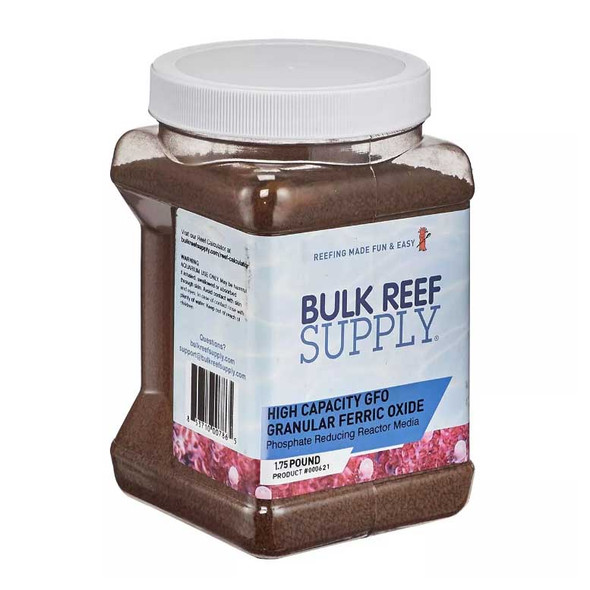Description
Phosphates are going to be one of the biggest battles we have with a reef aquarium. The BRS GFO works great in filter socks and reactors. For the price Standard Granular GFO is going to be one of the best values when it comes to GFO for phosphate removal.
Granular Ferric Oxide (GFO) removes phosphate from the aquarium and is one of the most commonly used filtration media used in the aquarium industry. GFO is one of the few ways to easily maintain ultra low phosphate on a consistent basis. Maintaining these ultra-low levels will help prevent algae outbreaks as well as treat existing algae issues. Your aquariums glass will also stay clear and free of the green hue significantly longer. GFO is most commonly used in a media reactor like the BRS reactor or media bag.
Phosphate inhibits proper coral growth by incorporating itself into the corals skeletal structure which makes it difficult for the coral to grow by laying down additional calcium and carbonate (alkalinity) ions. Maintaining ultra low phosphate levels will increase the growth of any SPS or LPS coral.
Algae outbreaks are one of the most common reasons for a complete tank shut down. We recommend preventing them by maintaining an ultra-low nutrient level environment where it would be difficult for them to get out of control to begin with. It is much easier to prevent outbreaks than it is to treat existing outbreaks.
GFO comes in two types:
- Granular GFO is varied in its shapes and requires the least amount of flow to tumble. Good for reactors.
- High Capacity GFO is twice as dense as Granular GFO, so twice as much material will fit into a reactor. It's extremely hard and has less dust to begin with. Fewer fines will be created during use and transportation. By volume High Capacity GFO will remove roughly twice the phosphate compared to Granular GFO. Best overall performance.
Special note on fighting existing algae problems: Algae needs three main nutrients to grow: phosphate, nitrate and light. Reducing any one of these will significantly slow down algae growth but may not completely solve your issue. Once algae takes hold, it can be a difficult battle but it is winnable. The best offense against algae is to take preventative measures and attack before an outbreak is apparent. Use the following suggestions and be aggressive if an algae problem is already present:
- Maintain undetectable phosphate levels with good feeding habits and use of a phosphate remover like GFO. 99% of all phosphate is added via foods added to the tank.
- Control nitrate levels by reducing feedings, increasing the water change schedule and maintaining a properly sized protein skimmer.
- Use nutrient-free RO/DI water for water changes and top off water
- Shorten your lighting period or intensity. In some cases aquarists have found replacing old bulbs that have fallen out of their intended spectrum helps as well
- Continuously remove as much algae as possible by hand.
- Add predators nothing helps an algae outbreak as much as critters who eat it all day long. Various tangs, lawn mower blennies, crabs and snails are all good options. It is also theorized that a healthy pod population will also control algae growth before it gets a chance to take root.
Note: All Bulk GFO is packaged by weight











